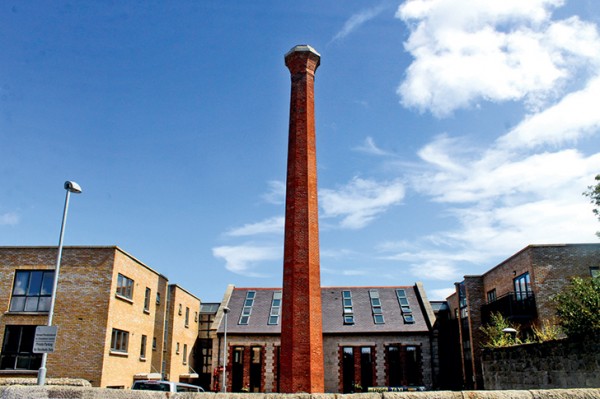
The fate of the iconic chimneys at Poolbeg is a little surer since mid-July when Dublin City Council voted to have them placed on the Record of Protected Structures.
The issue of whether they should stay or go exercised many people in the area and beyond. This is nothing new, however, as there are several other chimneys around the Dublin 4 area that have been preserved and protected, such as The Magdalene Laundry complex in Donnybrook, The Pump House on Londonbridge Road, The Swastika Laundry on Shelbourne Road and the old Hibernian Gas Works at Spencer Dock. NewsFour went to find out more about them.
The Swastika Laundry on Shelbourne Road, Ballsbridge, was founded in 1912 by John W Brittain. His grandson was interviewed on the Derek Mooney programme some years ago and explained that they chose the name because a swastika is an eastern good luck symbol and they had an ornament, a cat, with a swastika around its neck. His grandfather also had a famous race horse called Swastika Rose.
The word swastika is derived from the Sanskrit word svastikah, which means ‘being fortunate’, and was emblazoned on the laundry’s red brick chimney a full eight years before the German Nazi party decided to formally adopt the symbol. The symbol and name remained on the chimney until the late 1980s. There is an office development (pictured above) called The Oval surrounding the structure now.
One of the more contentious chimneys stands in Donnybrook, just behind the Garda station. It is the factory chimney for what used to be a Magdalene Laundry and has stood since 1796. It was built by two lay people before being passed on to the religious order in 1883.
The laundry was run by the Religious Sisters of Charity for more than a century and was one of four Magdalene facilities in Dublin – the others were in Drumcondra, Dún Laoghaire and Sean MacDermott Street. The Donnybrook facility accommodated between 100 and 120 women over much of the period of its operation.
The nuns eventually sold the laundry in 1992 to a private company, which ran it on a commercial basis until 2006. Two women who continued to live in the institution were subsequently employed by the laundry company. Only the tall chimney stack is listed for preservation.
NewsFour spoke to some local residents about their feelings towards the chimney, given the circumstances and conditions of the women who lived there. Tony from Belmont Avenue told us that he can see the structure from his window. “It’s been so much a part of the landscape that I never really noticed it until recently when there was a lot of coverage in the media about what went on in those places, I see it in a much different light now and it’s a little unsettling.” He went on to tell us he feels “there should be some sort of memorial garden around it when they develop the site.”
Another local we stopped on the street nearby didn’t want to be identified but told us “it should be ripped down, bulldozed and consigned to history!”
Sir John Rogerson’s Quay is the site of the most important chimneys in the area, given its original purpose, the old Hibernian Gas Company town gas production plant. Town gas was essential in the 19th Century and was produced from coal, then stored in gasometers.
In 1820, an act was passed for lighting Dublin city with gas, and by 1824 three public gas companies had set up shop. Town gas was originally a by-product of the coking process and was exploited for lighting, cooking and heating. The by-products – coal tars and ammonia – were important for the dye and chemical industry.
It was manufactured in a process called carbonisation. In this process, coal was distilled in a retort, a heated furnace. The temperatures in the retorts reached in excess of 1,000°C, the effect of which was to drive off the gas and other substances. The crude gas was sent through a series of cast iron pipes to the condenser, where it was cooled. As it cooled, the tar began to condense and was carried to an underground storage tank. A series of pumps called exhausters, powered by a steam engine, moved the gas from the retorts to the condenser through the remaining cleaning processes, called purification. This removed tar, ammonia and hydrogen sulphide.
The gas was then stored in gasometers for distribution, such as the one now developed into apartments in Ringsend, originally called The Alliance gasholder. The site around the chimney has now been developed into a playground with features like a wobbly play platform, palm trees and a blue lounging wall. Children from City Quay National School wrote a special poem called Talking Chimney that has been engraved into seats throughout the park.
by Steve Kingston

